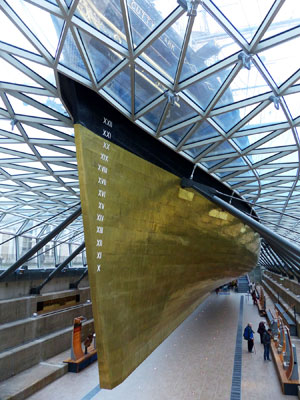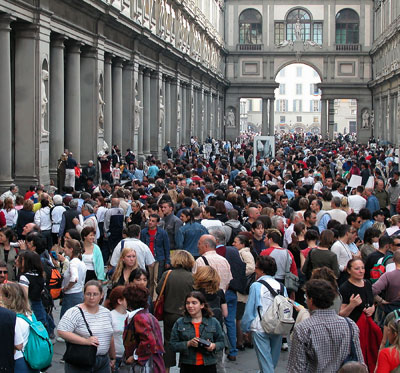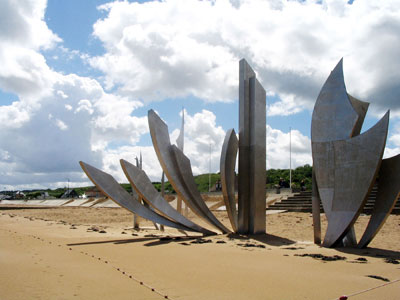New in Great Britain, Italy & France in 2014
This item appears on page 55 of the March 2014 issue.
For travelers to Great Britain, Italy or France, here are a few important changes to be aware of in 2014.
GREAT BRITAIN
• London continues to grow and thrive, post Olympics. Free WiFi is everywhere, bus transportation is more efficient than ever, and the city’s freshly scrubbed monuments have never looked so good.
Some of the biggest changes are in East London, where backhoes and bulldozers buzz around busily turning the 2012 Olympics site into what is now Queen Elizabeth Olympic Park (great for Londoners but a bit far from the center for most tourists).
The Shard, a shimmering glass pyramid that soars 1,020 feet above the Thames in central London, started welcoming visitors to its observation decks last year. Perched in the building’s pinnacle, the decks offer great views of the Tower of London (directly across the river), St. Paul’s and the South Bank (underfoot). But a visit to the top costs a jaw-dropping £25 ($41) for advance tickets — not worth it for most visitors.
Years ago, the venerable Tate Gallery split in two, with the original site dedicated to British art and the new site, the Tate Modern, filled up with modern art. An extensive renovation at the Tate Britain has wrapped up, which means even better gallery spaces in the oldest parts of the building.
Now the Tate Modern is adding a new wing (currently under construction yet opening bit by bit), allowing the museum to expand beyond its current European and North American focus with exhibits on Latin American, African and Asian art. A new space called the Tanks (formerly underground oil tanks) is already open and hosts live performances, film screenings and installations.
Hold onto your codpiece. Shakespeare’s Globe now boasts an indoor theater, the Sam Wanamaker Playhouse. It’s an intimate space designed to use authentic candle lighting for period performances, and it allows the Globe to stage plays year-round.
Greenwich’s famous Cutty Sark, the last and fastest of the great tea clippers, was gorgeously restored in 2012 after a devastating fire. It’s now suspended within a glass building, allowing visitors to walk on its decks, through its hold and below its gleaming golden hull. Multimedia and hands-on exhibits bring the ship’s record-breaking history to life.
• Finally, after nearly 5,000 years, Stonehenge has a decent visitors’ center. The new center features artifacts found at the site and a 360-degree virtual view of what the stone circle looked like back then.
The highway that once ran adjacent to the iconic edifice has been closed. Instead, people start at the visitors’ center, located more than a mile west of the stones, then take a shuttle or walk to the stone circle. Advance reservations are required (www.english
heritage.org.uk/stonehenge), and tickets feature a timed entry window (though a few walk-up tickets are available each day).
• In the Georgian city of Bath, the Georgian House, which gives an intimate look at life in the 18th century, has reopened following an extensive renovation.
The American Museum (I know, you need this like you need a Big Mac) on the outskirts of town is now easier to visit, thanks to a free hourly shuttle that runs from the town center.
• In Portsmouth, the Mary Rose Museum opened in May 2013. The £36 million ($58 million) facility, shaped like an oval jewel box, preserves the hull of Henry VIII’s favorite warship, which sank in 1545.
You can view the hull (through protective glass, for now), but the highlight is the collection of Tudor-era items that were found inside the wreck, such as clothes, dishes, weapons, a backgammon board and an oboe-like instrument. There’s even the skeleton of Hatch, the ship’s dog.
• In York, the renovation of the Minster’s Great East Window continues, with temporary exhibits that explain the project, such as the painstaking process of removing, dismantling, cleaning and restoring each of the 311 panels. The Minster’s new undercroft museum focuses on the history of the site and its origins as a Roman fortress.
Thirsty tourists will appreciate a new activity in town: an intimate, tactile and informative 45-minute tour of the York Brewery, a charming little microbrewery.
• In 2014, Glasgow will host the Commonwealth Games, July 23-Aug. 3, with 6,000 athletes expected to compete.
• The Battle of Bannockburn — Scotland’s most significant military victory over the English — will mark its 700th anniversary in 2014 on June 23-24. In honor of the occasion, the Bannockburn Heritage Centre in Stirling is being spiffed up and will reopen in March, with an interactive 3-D battle simulation and 360-degree film.
A 3-day festival called Bannockburn Live will take place June 28-30. Activities include music, Highland games, reenactments of the battle, and themed Scottish villages.
ITALY
• Florence is notorious for long lines at sights. Thankfully, ticketing and line-skipping options for the city’s blockbuster sights continue to improve.
The Firenze Card, which admits you to 60-some museums for €72 (near $99), is now good for these cathedral (Duomo) sights: Baptistery, Campanile bell tower, dome climb and Duomo Museum. If you want to see any single cathedral sight without a Firenze Card, you’ll need to buy the new 10-euro ($14) combo-ticket. It’s still free to enter the cathedral and have a look at Brunelleschi’s sublime dome from the inside.
At Florence’s Uffizi Gallery, known for Renaissance art, there’s an exciting change. A new gallery is devoted to Michelangelo, with his famous “Doni Tondo” painting of the Holy Family as its centerpiece. It’s the only easel painting that’s definitely known to be by the master’s hand.
• The private NTV/Italo high-speed train service is up and running, serving Florence along with Venice, Naples, Milan and Rome. Because railpasses are not accepted, pass holders should choose Trenitalia’s equally fast Eurostar Italia or Le Frecce services instead.
• Volterra has my vote for the best less-touristed hill town in Tuscany. Its new Alabaster Museum, featuring workmanship in the prized local stone from Etruscan times to the present, has opened within the 15th-century Pinacoteca painting gallery.
• In Rome, there’s good news for those traveling on a budget or who enjoy eating in bars (or both). A pleasant practice traditionally found in northern Italian cities has migrated south: the aperitivo service. Bars set up an enticing buffet of small dishes, and anyone buying a drink (at an inflated price) gets to eat “for free.” Drinks generally cost €8 to €10 (near $11-$13.50), and the spread is out from 6 until 9 p.m. Some places limit you to one plate; others allow refills.
Another dining trend in Rome is that small restaurants with a full slate of reservations for 8:30 or 9 p.m. often will accommodate walk-in diners earlier, if the diners are willing to eat a quick meal.
• Venice is working hard to cope with its mobs of visitors. As ever-growing waves of tourists wash over the city every year, residents are struggling to ward off the trash (and trashiness) left in their wake. Picnicking remains illegal anywhere on St. Mark’s Square, and offenders can be fined.
The city is taking a good-cop/bad-cop approach. On St. Mark’s Square, “decorum monitors” admonish snackers and sunbathers, while, around town, friendly posted guidelines cheerily encourage people to pick up their trash, refrain from pigeon-feeding and save the beachwear for the Lido.
Structural renovation work on the iconic bell tower that looms over St. Mark’s Square is finally finished. A titanium girdle wrapped around the underground foundations now shores up a crack that appeared in 1939.
The city’s top art gallery, the Accademia, is still undergoing a seemingly never-ending renovation, with major rooms still closed. The Peggy Guggenheim Collection has also done some rearranging, largely to accommodate the recently bequeathed Schulhof Collection, which brings the museum’s holdings up to the late 20th century with works by Rothko, Calder, de Kooning, Warhol and many others. Peggy would have loved it.
• In Ravenna, a new museum is dedicated to poet Dante Alighieri, who spent three years there before succumbing to an infernal (or, at least, malaria-ridden) mosquito. While it’s a buzz for Italians, it’s skippable for those who aren’t fans of the author and his work.
• Milan is preparing to host the 2015 World’s Fair. To welcome the expected 20 million visitors, the Rho-Pero district is revamping its layout with new parks, museums and American-inspired skyscrapers.
• Life is pretty much back to normal in the Cinque Terre, where flooding devastated the area just a few years ago, but the beautiful coastal trail system remains at the mercy of nature, with washouts or bad weather closing popular stretches. The popular Via dell’Amore (Path of Love), which was hit by a landslide in 2013, will reopen sometime in 2014.
In Vernazza, a new “beach” was formed with debris from the floods. It’s great for wading and sunning, but wear shoes, as bits of rubble are mixed in with the pebbles.
FRANCE
• The big news in Paris is that the extensive, multiyear makeover of the Picasso Museum is nearing completion. The museum, which will reopen sometime in 2014, is home to the world’s largest collection of Picasso works, representing the full range of the artist’s many styles. Check www.musee-picasso.fr for the latest.
Also in Paris, the Rodin Museum will stay open, though some rooms will close from time to time while renovation continues through 2015; on the plus side, visitors can currently enjoy some rarely displayed pieces and temporary exhibits (included in the ticket price). The museum’s gardens — one of Paris’ best deals at only €1 — also remain open.
Online reservations for the Eiffel Tower, notorious for its lines, are easy if you book at least a month in advance. You can print out a paper ticket or have the ticket sent to your mobile phone. An attendant scans the bar code on your phone and, voila, you’re on your way up.
St. Sulpice Church is no longer allowing visits to its massive pipe organ due to space constraints. However, the church’s superb organ recitals continue as usual.
Paris is going green. The Left Bank expressway from near the Orsay Museum to the Pont de l’Alma is being converted to a pedestrian promenade and riverside park and should be completed in 2014.
Modeled on the city’s popular Velib self-serve bike rentals, the Autolib’s electric car program (where users can pick up a car in one place and drop it in another) is a smashing success.
• In Arles, the new Fondation Van Gogh facility will open in early 2014 at Hôtel Léautaud de Donines.
The restoration of the city’s Roman Arena (Amphitheatre) is now complete, but the Arlaten Folk Museum remains closed until 2015.
• Marseille is still undergoing a massive, €3.5 billion face-lift as part of its designation as a European Capital of Culture for 2013. The pedestrian zone around the Old Port was redesigned (it’s now as wide as the Champs-Élysées), and a new tramway system is up and running.
• In Nice, construction on the green parkway La Coulée Verte continues. When completed, the 30-acre parkway will extend from the sea through Place Masséna to the Museum of Modern Art, carving a people-friendly swath for biking and walking through Nice’s urban center.
• In the Dordogne region, the prehistoric cave-painting sight Grotte de Font-de-Gaume currently is not taking reservations and is admitting just 80 people a day. Some visitors are camping out overnight to get a ticket. I recommend getting there by 7:30 a.m.; the ticket booth opens at 9:30 a.m.
At the Lascaux II cave, reservations are strongly recommended for July and August and are accepted only three or four days in advance. Tickets are available at the tourist office in nearby Montignac. Of the prehistoric sights in the region, only the Lascaux II, Pech Merle and (in July and August) Abri du Cap Blanc caves take reservations; for all others, it’s first come, first served.
• In Normandy, June 6, 2014, will mark the 70th anniversary of the landings of the Allies on French soil during World War II. There will be huge D-Day commemorations around this date, so anyone planning a Normandy trip near the anniversary will need to have booked accommodations months in advance.
New at the Caen Memorial Museum is the restoration of German General Wilhelm Richter’s command bunker next to the museum.
• At Mont-St-Michel, 2014 is the last year for the causeway that visitors have used for more than 100 years. It’s slated to be demolished by 2015. Restoration of the island’s ramparts may block some island walkways.
• In Bayeux, the MAHB (Musée d’Art et d’Histoire Baron Gérard) has reopened, offering a modest review of European art and history in what was once the Bayeux bishop’s palace. Bayeux’s three main museums — the Bayeux Tapestry, Battle of Normandy Memorial Museum and MAHB — offer combo-tickets that will save visitors money if they plan to see more than one sight.
• And, as 2014 marks the centennial of the outbreak of World War I, all will not be quiet on the Western Front. WWI buffs will find plenty of special exhibits and a surge in activity at many sites in commemoration of the battles that hit Europe in 1914.



